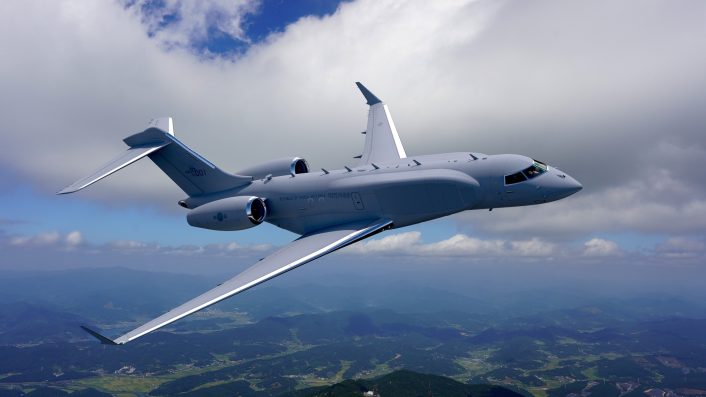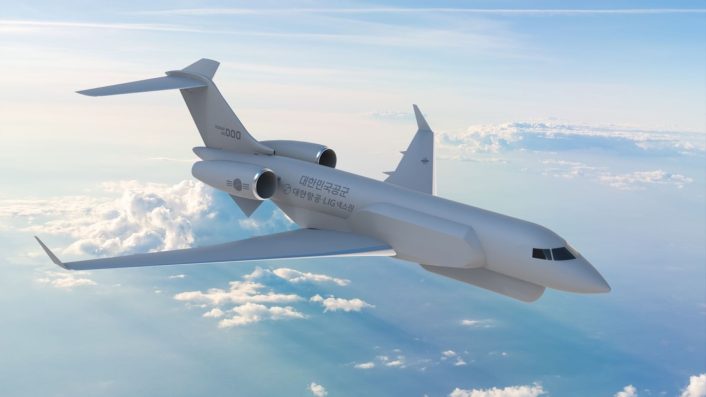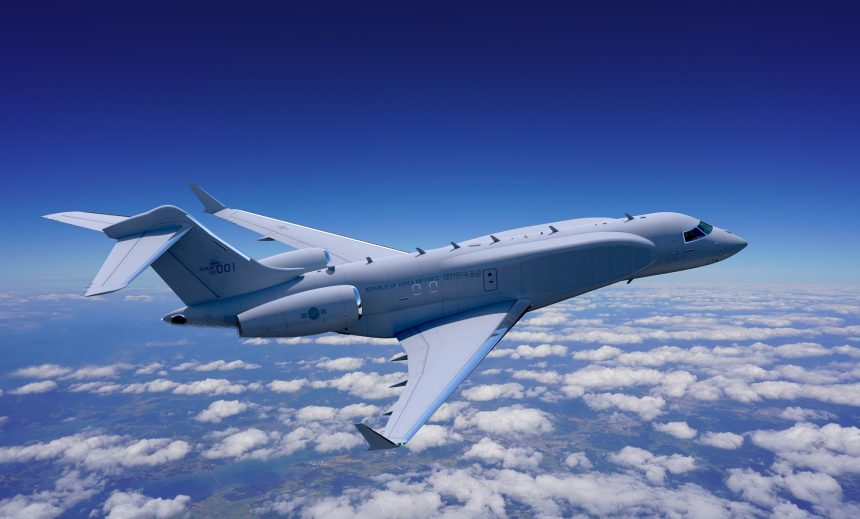South Korea aims to develop homegrown airborne EW and stand-off jamming technology as part of the Block-I Electronic Warfare System Development Project.
In response to South Korea’s Block-I Electronic Warfare System Development Project, the Defense Acquisition and Program Administration (DAPA) is examining concepts and bids by another consortium of local defense and aerospace majors. The KRW 1.775 trillion ($1.3 billion) investment plans to induct an unidentified number of aircraft, which reports say is four, by 2034.
KAI (Korea Aerospace Industries) and Hanwha Systems formally unveiled in a press release on Sep. 28, 2025, their concept for the project, based on a Bombardier Global 6500 aircraft. The EW/SOJ (Electronic Warfare/Stand Off Jammer) aircraft is reported to offer capabilities and technology comparable to the U.S. Air Force’s EA-37B Compass Call.
The Block-I program evolved to develop an indigenous system, given the strategically sensitive nature of electronic warfare technology. Even Japan has announced plans for its own EW system, based on its domestically-developed Kawasaki P-1 MPA (Maritime Patrol Aircraft).
Another contender for the program is a tie-up between Korean Air and LIG Nex1, which reports from Korea said is in the lead. DAPA is expected to announce the contract winner by October.
While KAI and Korean Air will conduct modifications on the Global 6500 and/or Gulfstream G550 aircraft, respectively, along with the final production rollout, Hanwha and LIG Nex1 will develop, test and install the requisite EW/SIGINT/Jamming equipment, mission systems and software.

KAI-Hanwha airborne EW concept
In its press release, KAI said it unveiled a preliminary design at the 2025 Electromagnetic Warfare Workshop held at the aTCenter in Seoul on Sep. 17, adding it has now submitted a formal bid to the DAPA. The rendering released by KAI shows a conformal array, almost along the entire length of the Global 6500’s fuselage, along with antennas and sensors on the dorsal side.
KAI’s EW/SOJ (Stand Off Jamming) concept “goes beyond a simple aircraft shape; it is the result of synthesizing the domestic aircraft development capabilities and technologies accumulated over the past 40 years as the only complete aircraft system integration company in Korea,” says the company.
Regarding the system’s design configuration, KAI said its fully side-mounted arrays take into account “aircraft output and center of gravity, cooling/power system integration, maximizing radar and antenna performance, and enhancing survivability, as well as the fuselage of the Bombardier G6500, the basic platform for this electronic warfare project.”
KAI added the EW equipment installed on the aircraft underbelly area reduces the overall aircraft height from the ground, risking collision “in the event of an abnormal situation such as a tire rupture,” and measures were taken to avoid such risk.
“Accordingly, KAI and Hanwha Systems adopted a design that realizes the miniaturization and lightweight of the electronic warfare execution system and integrates it on both sides of the fuselage,” explains KAI. “[This minimizes] the degradation of the aircraft performance while reducing interference with various antennas and maximizing electronic warfare execution capabilities.”
South Korea’s ROKAF is said to be looking at this kind of AEW&C platform to augment its existing, conventional config E-7A Peace Eye AEW&C.
Current plan looks into Korean Air collaborating wiv L3 Harris and ELTA pic.twitter.com/t0jWt1G7Hg
— Garuda Rajawali (@GardaAramis) September 28, 2025
KAI also draws a comparison with the EA-37B Compass Call, calling it the “most powerful electronic warfare aircraft in existence,” saying it has the same design, with a “focus on simultaneously securing electronic warfare mission capabilities and aircraft flight safety.”
KAI then highlighted its prime contractor role in the Baekdu-II project to develop and manufacture four ISR aircraft; the successful completion of the Peace Eye program by integrating the RoKAF’s version of the E-7A Wedgetail, the E-737; the P-3CK Maritime Patrol Aircraft; the development of new aircraft and helicopters like the KT-1, T-50/TA-50/FA-50, KF-21, KUH, and LAH.
Korean Air-LIG Nex1 proposal
The other competitor, a consortium of Korean Air and LIG Nex1, announced the partnership on Sep. 21, according to Yonhap. The publication added that both companies “planned to submit their final proposal for the project in early September.”
This was followed by a FlightGlobal report on Sep. 24 mentioning the Korean Air-LIG Nex1 bid “pulled ahead in the competition.” The report also quoted company officials who said that it was the “highest scoring bidder” in the project.

There are conflicting reports on the choice of the carrier aircraft for the Korean Air-LIG Nex1 concept. FlightGlobal reported that Korean Air confirmed the aircraft will be based on the Global 6500, while Janes reports it will be based on the Gulfstream G550.
The Korean Air concept has a conformal sensor on the front portion of the side fuselage, running between the wing root and the front section, along with a large ventral array. Both configurations are consistent with aircraft in the airborne SIGINT and electromagnetic spectrum warfare roles.
The future of electronic warfare in action!
The 43rd ECS just flew the first training sortie for the EA-37B, a cutting-edge electromagnetic attack aircraft that provides enhanced capabilities to disrupt adversary networks and support our forces. 👇https://t.co/6QbrHVI80K pic.twitter.com/sMjq8eUphu
— Air Combat Command (@aircombatcmd) May 13, 2025
Chosun reported on Sep. 22 that the Korean Air and LIG Nex1 proposal “scored higher” in the bid evaluation process by DAPA, but an “objection process” still remains before the final contractor is chosen. DAPA “has been evaluating each company’s electronic warfare equipment technology and airframe integration capability, among other factors,” Chosun added.
‘Need for homegrown EW technology’
The publication also reflected the government’s vision to be self-reliant in EW technologies, and reduce reliance on U.S. EW aircraft, from whom “technology transfer is also limited.”
Chosun added that the country needs a jamming range of “at least 200 km to cover the entire Korean Peninsula.” Additionally, “high-performance transmit-and-receive antenna technology is required to secure enemy electronic signals while disrupting the enemy by emitting powerful radio waves.”









